 Facebook
Facebook
 X
X
 Instagram
Instagram
 TikTok
TikTok
 Youtube
Youtube
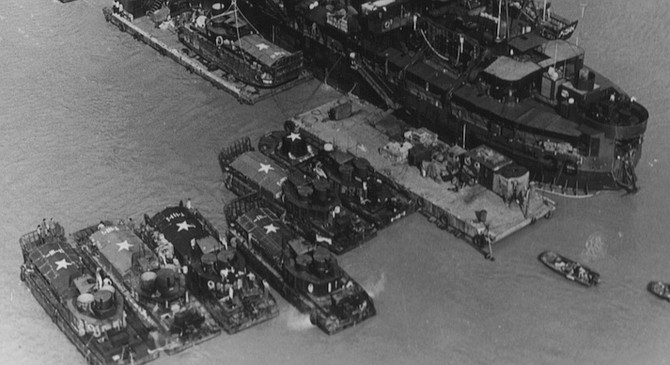
Mark said he’d had some bitter experiences with black sailors on the ship. When a group of recruits came on board, he lined them up to get some paperwork information. “Hey, mothuh, when we gonna get paid?” they bombarded him. There was a little sting in his voice as he said this, but he was fairly philosophical about it. He said he’d read about the Defense Department’s attempt in the Sixties to recruit out of the ghetto and that the Navy had probably been overzealous in its recruiting.
By Ralph Jackson, December 14, 1972 | Read full article
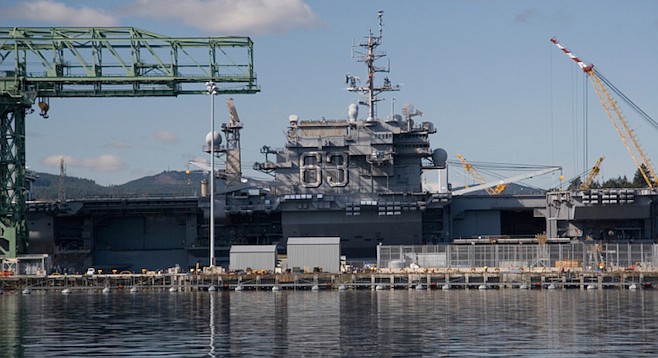
Immediately following air operations aboard the Kitty Hawk on the evening of October 12, 1972, a series of incidents broke out wherein groups of blacks, armed with chains, wrenches, bars, broomsticks and other dangerous weapons went marauding through sections of the ship disobeying orders to cease, terrorizing the crew, and seeking out white personnel for senseless beating, with fists and with weapons which resulted in extremely serious injury to three men and the medical treatment of many more, including some blacks.
By Glenn Daly, November 25, 1993 | Read full article
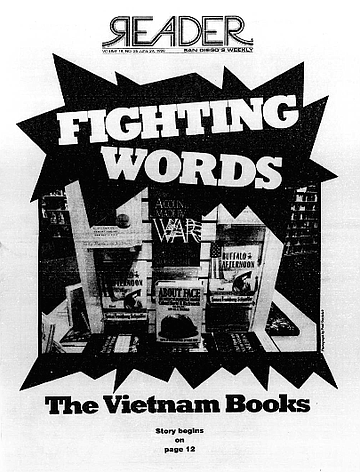
When his students asked him to suggest of Vietnam combat novel, Fields of Fire was what he recommended. He'd read Going After Cacciato, but had found its premise — from a squad that is stationed near the Laos border, one member takes off, heading for Paris, and the entire squad is ordered to track and capture him — "shaky." Stephen Wright's Meditations in Green he'd liked "for the risks he took, using poetic language, for the description." The Short-Timers by Gustav Hasford he'd found particularly realistic. He liked its rapidity, it's quick cuts and splices. "Hasford's book, yep, that's pretty much what it was like up there."
By Judith Moore and Mary Lang, June 29, 1989 | Read full article

When the doors opened, I was surprised to see a commercial aircraft; I expected to fly to Vietnam on a military aircraft, like a C-124 transport, like in the movies. We boarded the plane and were crammed in. The seat in front of me came tight up to my knees. We had stewardesses on the flight, and they served meals and drinks, just like it was a regular civilian flight. All of us were probably thinking the same thing. How many of us would be taking this same flight back a year from now?
By M.J. Serenko, April 2, 1987 | Read full article
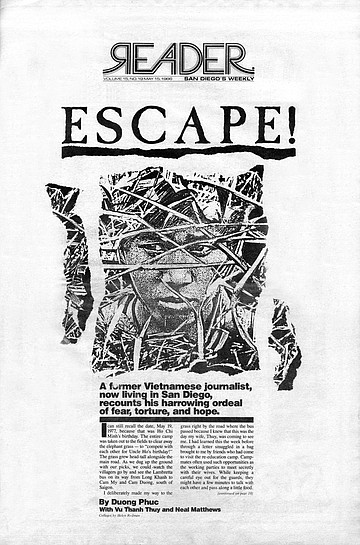
Then he emptied out the bag before us. Two small cans and some plastic sacks with lump sugar, salt, and sesame seeds fell to the ground. Glancing around, I could see that all my friends had stopped working and were watching everything that happened. From far off, Cadre Binh, the commander of the camp guards, was running over. As soon as he reached me, he lashed out and slugged me in the face. I crumpled to the ground and received a hard kick in the ribs.
Duong Phuc with Vu Thanh Thuy and Neal Matthews, May 15 and 22, 1986 | Read full article
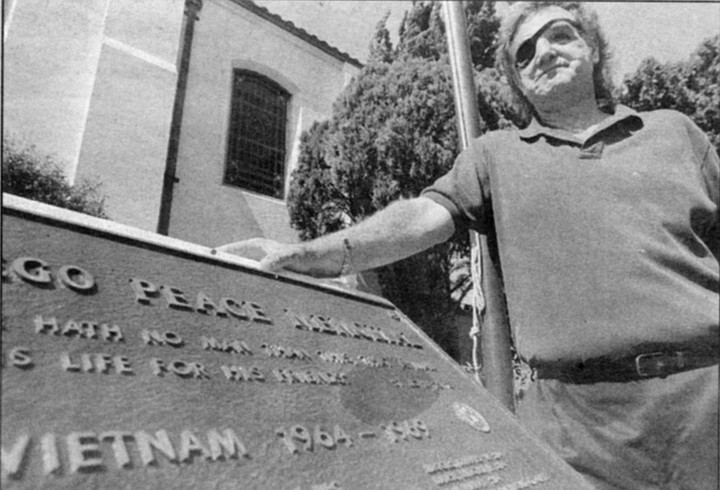
When Stadtmiller received his Purple Heart, the general who presented the medal explained that this was one medal few wanted. "I threw the thing away," Stadtmiller said. Nearly a quarter of a century later, however, Stadtmiller ordered another. By then, he said, in accepting his own history, his wounds, the life he'd helped to make with his family, and the work he was doing with other Vietnam War veterans, he felt he'd earned his Purple Heart.
By Hawkins Mitchell, May 29, 1997 | Read full article
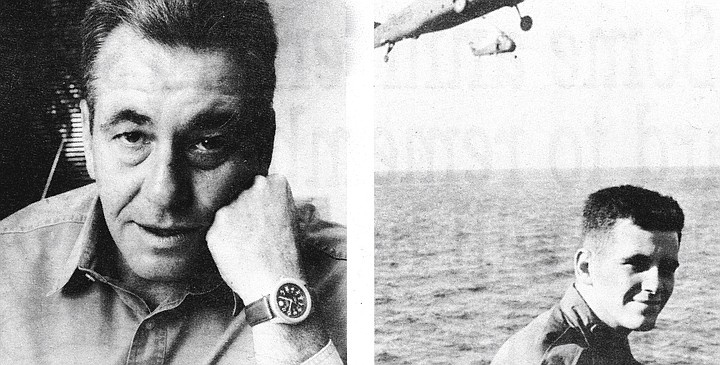
I think the public as a whole couldn't care less, but those who do care don't know that there were two wars going on. Everyone thinks we were running around chasing Vietcong in black pajamas and conical hats. That's not true. The real war was up in the DMZ (Demilitarized Zone) with the NVA (North Vietnamese Army). These are the guys with the flamethrowers at Con Thien, better equipped than the Marines, you know. As FO (Forward Observer) I personally saw I don't know how many thousands of NVA infiltrators. This was big-time warfare.
By Ray Westberg, November 7, 1997 | Read full article
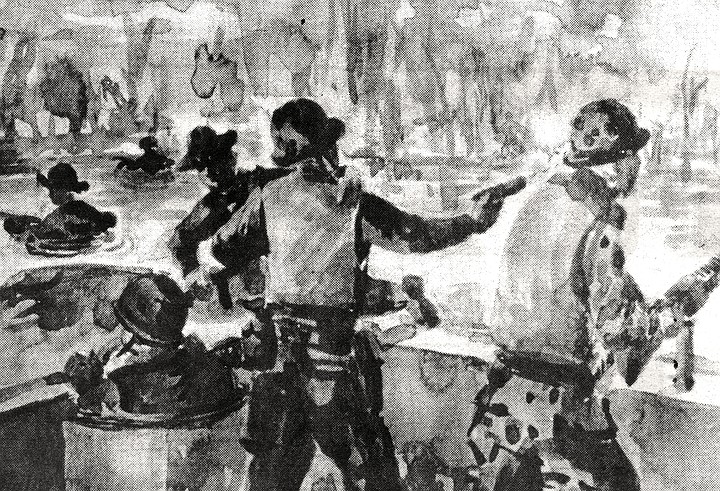
The U.S. Army has had combat artists in the field since World War I. Navy and Marine Corps programs came early in the next war. On a limited scale, the programs still exist, with combat artists assigned to Desert Storm, Somalia, and Bosnia. Their work is collected in the history museums of each branch of the service — millions of images of the terror and tedium of military life interpreted through the artist's eye.
By Linda Nevin, Jan. 27, 2000 | Read full article


Mark said he’d had some bitter experiences with black sailors on the ship. When a group of recruits came on board, he lined them up to get some paperwork information. “Hey, mothuh, when we gonna get paid?” they bombarded him. There was a little sting in his voice as he said this, but he was fairly philosophical about it. He said he’d read about the Defense Department’s attempt in the Sixties to recruit out of the ghetto and that the Navy had probably been overzealous in its recruiting.
By Ralph Jackson, December 14, 1972 | Read full article

Immediately following air operations aboard the Kitty Hawk on the evening of October 12, 1972, a series of incidents broke out wherein groups of blacks, armed with chains, wrenches, bars, broomsticks and other dangerous weapons went marauding through sections of the ship disobeying orders to cease, terrorizing the crew, and seeking out white personnel for senseless beating, with fists and with weapons which resulted in extremely serious injury to three men and the medical treatment of many more, including some blacks.
By Glenn Daly, November 25, 1993 | Read full article

When his students asked him to suggest of Vietnam combat novel, Fields of Fire was what he recommended. He'd read Going After Cacciato, but had found its premise — from a squad that is stationed near the Laos border, one member takes off, heading for Paris, and the entire squad is ordered to track and capture him — "shaky." Stephen Wright's Meditations in Green he'd liked "for the risks he took, using poetic language, for the description." The Short-Timers by Gustav Hasford he'd found particularly realistic. He liked its rapidity, it's quick cuts and splices. "Hasford's book, yep, that's pretty much what it was like up there."
By Judith Moore and Mary Lang, June 29, 1989 | Read full article

When the doors opened, I was surprised to see a commercial aircraft; I expected to fly to Vietnam on a military aircraft, like a C-124 transport, like in the movies. We boarded the plane and were crammed in. The seat in front of me came tight up to my knees. We had stewardesses on the flight, and they served meals and drinks, just like it was a regular civilian flight. All of us were probably thinking the same thing. How many of us would be taking this same flight back a year from now?
By M.J. Serenko, April 2, 1987 | Read full article

Then he emptied out the bag before us. Two small cans and some plastic sacks with lump sugar, salt, and sesame seeds fell to the ground. Glancing around, I could see that all my friends had stopped working and were watching everything that happened. From far off, Cadre Binh, the commander of the camp guards, was running over. As soon as he reached me, he lashed out and slugged me in the face. I crumpled to the ground and received a hard kick in the ribs.
Duong Phuc with Vu Thanh Thuy and Neal Matthews, May 15 and 22, 1986 | Read full article

When Stadtmiller received his Purple Heart, the general who presented the medal explained that this was one medal few wanted. "I threw the thing away," Stadtmiller said. Nearly a quarter of a century later, however, Stadtmiller ordered another. By then, he said, in accepting his own history, his wounds, the life he'd helped to make with his family, and the work he was doing with other Vietnam War veterans, he felt he'd earned his Purple Heart.
By Hawkins Mitchell, May 29, 1997 | Read full article

I think the public as a whole couldn't care less, but those who do care don't know that there were two wars going on. Everyone thinks we were running around chasing Vietcong in black pajamas and conical hats. That's not true. The real war was up in the DMZ (Demilitarized Zone) with the NVA (North Vietnamese Army). These are the guys with the flamethrowers at Con Thien, better equipped than the Marines, you know. As FO (Forward Observer) I personally saw I don't know how many thousands of NVA infiltrators. This was big-time warfare.
By Ray Westberg, November 7, 1997 | Read full article

The U.S. Army has had combat artists in the field since World War I. Navy and Marine Corps programs came early in the next war. On a limited scale, the programs still exist, with combat artists assigned to Desert Storm, Somalia, and Bosnia. Their work is collected in the history museums of each branch of the service — millions of images of the terror and tedium of military life interpreted through the artist's eye.
By Linda Nevin, Jan. 27, 2000 | Read full article
Comments